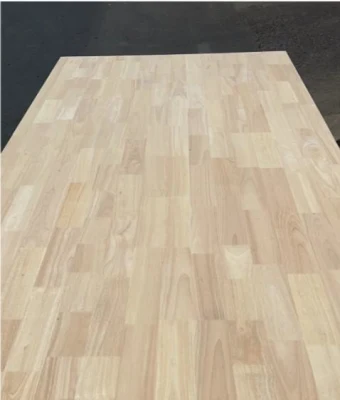Basic Info.
Product Description
Rubber Wood Finger Joint Board
Rubber Wood Finger Joint Boards
Rubber Wood Finger joint laminated board is a solid wood board made by combining many laminates by finger joint or butt joint method into usable lengths strips. These strips are then pressed and laminated together by special glues (2 components adhesive) by hydraulic press machines to become the finger joint laminated board. The laminated board has many advantages that solid wood conventionally does not have. For instance, warping or twisting, which occurs in woodwork manufacturing process could be avoided if we use laminated board instead of solid wood.



Finger Joint Boards can be used to make Table Tops , Bar Tops, Chair Seat, Stair Treads, Drawer fronts, Parquet Floors, Internal Doors, Domestic Joinery, Furniture Fixtures, Wall shelves & fixtures, Indoor building components.
Appearance
A/A Grade: both faces are clear, free of knots. This is reason why the strip is cut into small pieces to afterwards join them together again along the longitudinal plane: the result is a completely clean board.Physical Properties
- Grain: Straight, except for rings close to the pith
- Texture: Homogenous and fine
- Scent: Slightly sappy
- Thermal conductivity: 0,104 λ (W/mK)
- Nominal density: 480 Kg/m3
- Permeability: Retention > 240 kg/m3
- Shrinkage coefficient: Volumétrica (14,5 %); Tangencial (7,4 %); Radial (4,2 %)
- Durability: Category 3
Mechanical Properties
- Janka Hardness: 3600 N
- Modulus of rupture: 825 Kg/cm²
- Modulus of elasticity: 80547 Kg/cm²
- Compression resistance: 360 Kg/cm²
Dimensions (measurement values are indicated in mm)
- Length: 2250 - 2200 - 2440 - 3000
- Width: 1220
- Thickness: 10 - 12 -15- 16 -17- 18 -20- 22 -24 - 30 - 40
Applications
In accordance with The Spanish Association of Standardisation, the edge glued Rubber panels are classified as follows:- Regarding the conditions in which it is utilized: SWP (1= dry )
- Regarding its mechanical properties: SWP 1 NS (NS= non- structural, non-structural application)
Workability
- Cutting: Easy
- Drying: Fast
- Planing: Easy
- Gluing: Easy
- Nailing and screwing: Easy
Conservation and Storage
Our experience with Rubber and finger-joint panels made of this raw material allows us to know the possible modifications or damage that the product might suffer in the event that a series of recommendations regarding basic conservation and storage were not taken into consideration to preserve its durability and stability.In wanting to avoid warping of the panel or edging of the strips that are at the edges we suggest the following recommendations:
- Do not subject the plank to sudden temperature and or moisture changes. Wood is sensitive to variations in the stability of the atmosphere surrounding it.
- Avoid storing the panels of wood in direct contact with floors and walls.
- Keep the original packaging, which were provided with the goods whether it be one by one or altogether, avoiding contact with the atmosphere for a prolonged period of time if the goods have not been rearranged or moved from the initial positioning - once the piece which is going to be put to use has been removed.
- Apply varnish, lacquer, paint or similar chemical treatment or equivalent that enhances the resistance of the panel/board and is not incompatible, in accordance with the fact sheet provided by the manufacturer, with the wood in itself or the adhesive used to glue.



